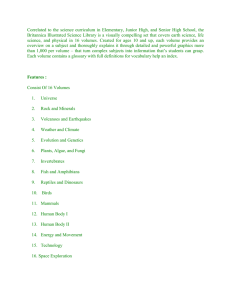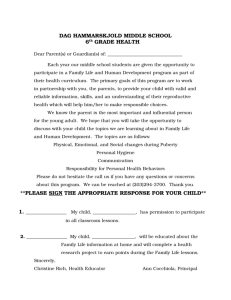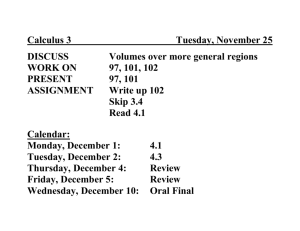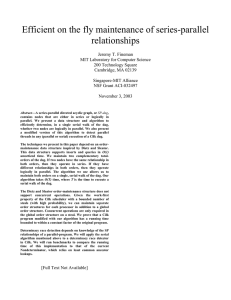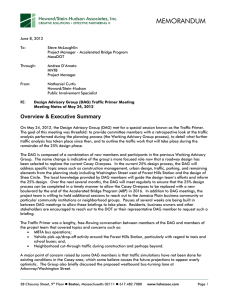DAG Traffic Primer May 24, 2012 CASEY ARBORWAY PROJECT
advertisement
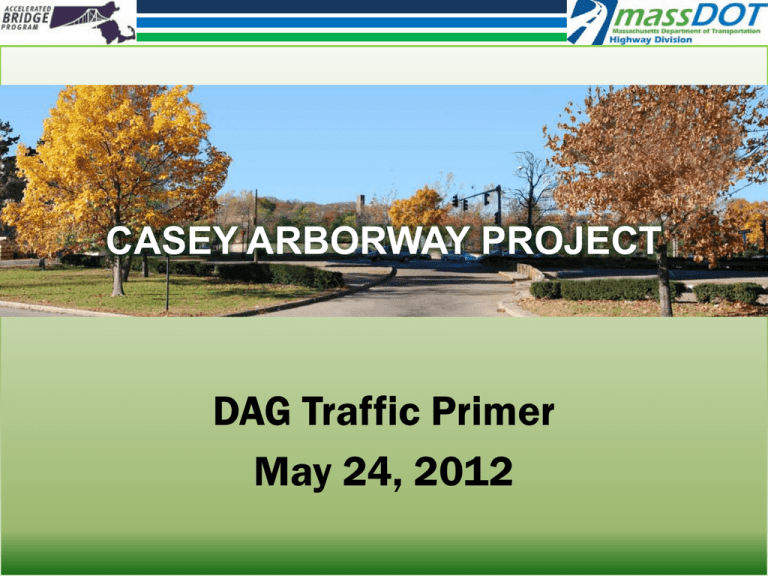
CASEY ARBORWAY PROJECT DAG Traffic Primer May 24, 2012 Today’s Agenda 1. Previous Traffic Analysis Summary 2. Updates Post Planning Phase 3. Signal Coordination 4. Parking Supply 5. Transit Service and Accommodations 6. DAG #3: Mobility, Monday, June 18, 2012 Topics Requested •Key Assumptions in Traffic Analysis •Traffic Calming •Level of Service (LOS) & Queue Results •Right Turn Treatments •Traffic Operations •Pedestrian Crossings •Transit Accommodations •Emergency Response Times •Alternative Routes Specific Questions 1. Future queue lengths at key intersections 2. Pros and cons of slip lanes and pork chops 3. Signal timings, particularly for pedestrians 4. Explanation of the key assumptions that feed into traffic analyses 5. Explanation of how buses coming from the east (Dorchester and Mattapan) will be accommodated DAG Welcome Questions Topic Response How to calm traffic with wide median DAG #3 Rights on Red Allowed Design allows but requires further discussion on DAG #3 Level of Service (LOS) Presentation today LOS with 2-lanes in each direction DAG #3 Location of Pedestrian and bike paths DAG #3 Path Analysis for all modes – Experience Presentation today of Corridor DAG Welcome Questions Topic Response North/south and east/west traffic flows Clarify Alternative Regional Routes - Walk Hill? Clarify – Design or Construction Phase? Parking – loss of off-street impacts on design Presentation today Emergency Response during Construction DAG #4 24 hour review of traffic volumes (peak and non-peak) Presentation today Previous Traffic Analysis Summary A Look Back Early in the Project Strong community directive to study and fix the surface street network regardless of a bridge or at-grade replacement alternative Key Assumptions in Traffic Analysis Top 5 Areas of Concern Today 2035 Multi-Modal Traffic Operations • Address local surface system and intersections • Address pedestrian, bicycle and transit access, circulation and crossings • Accommodate regional traffic without adversely impacting local conditions • Allow for a local network to support future development and abutting neighborhoods 2035 Future Traffic Volumes 2035 Regional Model (CTPS) Local Development Parcels (City) 2035 No Build Traffic Volumes 2035 Future Growth Summary Vehicular Volumes: Casey Overpass (Regional): + 5% Surface Roads (Regional & Local): + 12% Non-Motorized (Peds & Bikes): + 13% Transit Ridership: + 10% How the Analysis was Performed 1. 2. 3. Base Year Calibrated – 2010 Forecast Year Future – 2035 Alternatives developed – CTPS performed regional analysis • • • 4. 5. Overall volumes Travel times Air Quality Regional analysis results provided to project team Project team examined local traffic operations Traffic Calming Traffic Calming Treatments Design is ongoing 1. 2. 3. Landscaping Crosswalk Treatments Signal Spacing Level of Service & Queue Analysis Results Existing Traffic Operations • Most of the study area intersections operate at overall Level of Service (LOS) “E;” with specific movements at LOS “F” • Queues exceed existing storage space Future No-Build Traffic Operations • LOS and delay decline over existing conditions • One intersection operates at overall LOS “F” • Queues exceed current storage space Future Build Traffic Operations • Vehicular LOS improves at study area intersections; most at LOS “D” or better. • Queues are managed between intersections • Analysis included both North-South and East-West corridors • Pedestrian and Bicycle operations at LOS “C” or better. • Surface streets are organized into conventional intersections; the missing East-West link is provided Regional Analysis Central Transportation Planning Staff Analysis CTPS Regional Traffic Model • Model runs for At-Grade and Bridge Alternatives • Initial results show no significant changes to: • Traffic Volumes • Vehicle Miles Traveled (VMT) • Vehicle Hours Traveled (VHT) • Air Quality/Emissions CTPS Key Findings • Both build scenarios allow the same magnitude of traffic to move through this area • Both build scenarios cater to the same markets • Both build scenarios result in similar travel times for trips Detailed LOS and Queue Analyses • Traffic Operations Improved for both alternatives over existing conditions (see Technical Memoranda) • Acceptable traffic operations provided for both alternatives • Queues managed within available storage area • Operations comparable for at-grade and bridge alternatives Travel Time Comparison • Travel times for existing based on current volumes and presented for comparison only • Travel times for alternatives based on 2035 volumes and analysis • Travel times are for peak hours Peak Hour Travel Time Results • Both alternatives improve overall travel times within the project limits • Overall travel times for the alternatives are comparable • At-grade improves travel time for many moves, particularly north-south • At-grade increases travel time for affected left-turns and east-west regional traffic (30-90 seconds) • Regional delays offset local travel time increases Future Operations with Modified Lane Configurations Design is ongoing Further Discussed at DAG #3: Mobility (6-18-12) 1. Pros and Cons of different lane configurations 2. Queues and signalization 3. Right sizing roadway 2016 versus 2035 Right-Turn Treatments Design is ongoing Further Discussed at DAG #3: Mobility (6-18-12) 1. 2. 3. Pros and Cons of channelized right turns Right-Turn-on-Red Pedestrian Signal Timing Traffic Operations Future Traffic Conditions: Summary • Pedestrian/Bike/Transit Operations Improved • Overall Vehicle Capacity Increased • No Added or Diverted Traffic • Overall Travel Times Remain Constant East West Regional Travel • Regional travel times relatively unchanged for overall trip • Any in-bound delays at grade on New Washington are offset by existing delays at Murray Circle • In fact, the new design of New Washington may “meter” the travel times, providing more systematic processing of traffic Bar chart of traffic by time of day Discussion Pedestrian Crossings Pedestrian Crossings Design is ongoing Will be further examined in DAG #3: Mobility 1. Ongoing efforts to minimize the pedestrian crossing distance 2. Location of pedestrians within the cross-section 3. Pedestrian Signal Timing – length of walk phase, exclusive versus concurrent phasing Transit Accommodations Transit Signalization 1. Bus Signal Phases 2. “7th lane” 3. Deadhead Buses School Bus Coordination • Met with Boston’s School Department BusOperations on 5-15-12 • Meeting with METCO bus service on 5-25-12 Ongoing MBTA Coordination •Compiling data on bus volumes by peak hour, including deadhead buses •Coordination on bus priorities Emergency Response Time Emergency Response Times • Future Build Condition = Faster Emergency Response Times • Construction Design is ongoing More at Construction Management DAG Meeting (7-18-12) Alternative Routes Alternative Routes • Future Build Condition = Traffic Diversions are not anticipated • Construction Design is ongoing More at Construction Management DAG Meeting (7-18-12) Local Diversions (cut-through) • Concerns on cut through focused on east/west travel. • The At-Grade Alternative increases east/west travel by only 30 to 90 seconds. • The travel times along alternate routes (potential cutthrough routes) are greater than the proposed at-grade network. For more Information: Project Web Site For Detailed Results Casey Project Web Site Documents http://www.massdot.state.ma.us/caseyoverpass/ Traffic Documents • Traffic flow maps by mode • Level of Service by Mode • CTPS graphics • Travel Time Analysis Meetings • Notices • Presentations • Graphics • Minutes Previous Traffic Discussions Discussed at 11 WAG & 5 Public Meetings Primary Traffic meetings included: • Public Meeting #1 – 4/6/11 • WAG 2B – 5/4/11 • WAG 3B – 6/14/11 • WAG 5A – 9/28/11 • WAG 5B – 10/25/11 • Public Meeting #5 – 11/21/11 Updates Post Planning Phase Traffic Peer Review Conducted by CDM Smith Dec. ‟11–Jan „12 “Summary: • …, the traffic analysis provided for the Casey overpass Project has been performed in a professional manner consistent with standard traffic engineering practices and the guidelines of the MassDOT 2006 Project Development and Design Guidebook. • …traffic operations will be more efficient in the future year with either alternative than the existing conditions or no build conditions.” Additional Review conducted By notable traffic advocates “Report on Evaluation of Two Design Options for Casey Overpass” Volume Graphics Updates • Traffic count data for Cemetery Road • Bus left-turn volumes • Minor graphic clarifications • Adjusted volumes at Orchardhill Road Ongoing/Future Traffic Analysis Summary A Look Ahead Signal Coordination Coordinated Signal Systems: •Casey Arborway (E-W) •Washington Street (N-S) •Hyde Park Avenue (N-S) Parking Supply On and Off-Street Existing Parking Supply Proposed Parking Supply Parking Changes Parking changes were reflected in the future traffic volumes –(i.e. -LAZ parking lot) Next Steps: DAG #3: Mobility Topics DAG #3 Mobility Topics: •Off-Peak Design Options •Build Year LOS, queues, delays •Turn Treatments •Signal Details •Bus Operations •Cut-Thru Traffic Casey Arborway Project Discussion End of Presentation Extra Slides Conceptual Alternatives TRAFFIC Traffic Simulations Bridge Alternative At-Grade Alternative How can traffic operations be similar? • North-south traffic volumes unchanged between alternatives • At-grade offers additional improvements to critical northsouth link on South Street • Removal of Bridge only adds east-west through traffic to surface streets (additional thru lanes provided at-grade) • All turning movements happen at grade regardless At-Grade Conceptual Alternative DESIGNER GENERAL’S WARNING: THE DESIGN SHOWN HERE IS PRELIMINARY AND CONCEPTUAL, DESPITE THE HARD LINE FINISHED STYLE RESULTING FROM THE SOFTWARE PROGRAMS USED Bridge Conceptual Alternative DESIGNER GENERAL’S WARNING: THE DESIGN SHOWN HERE IS PRELIMINARY AND CONCEPTUAL, DESPITE THE HARD LINE FINISHED STYLE RESULTING FROM THE SOFTWARE PROGRAMS USED
